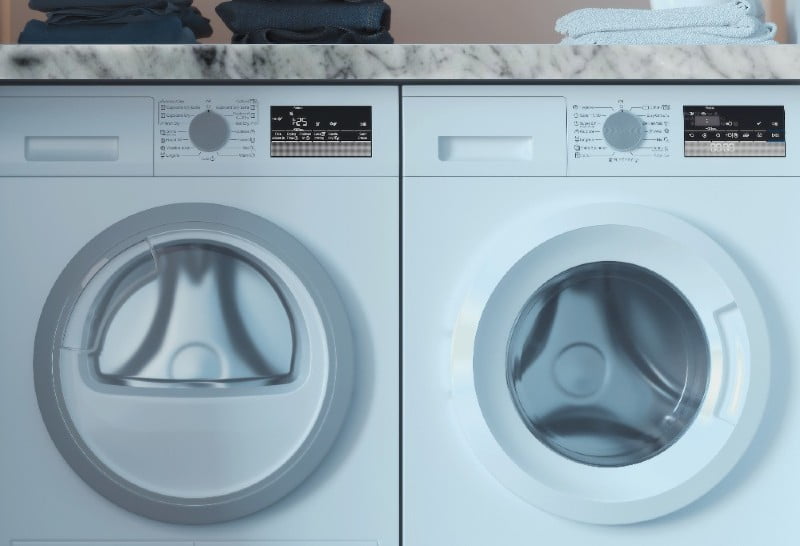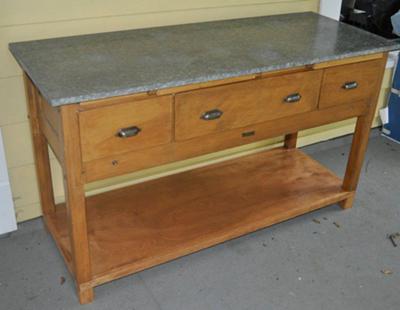Supporting Marble Slab Countertop
QUESTION
I recently had a 3/4" Carrara marble slab with a 1 1/2" mitered edge installed over my washer and dryer. Beforehand, I had a 5/8" sheet of plywood installed, supported on three sides. Today I noticed slight, thin cracks in the middle of the edge.
The marble countertop fabricator/installer did not glue the marble down to the plywood and put a tile backsplash around the marble.
The plywood seems to be sagging in the middle, not fully supporting the weight of the marble slab. I have not put very much weight on the counter.
Am I going to have an issue with this marble slab countertop cracking? If so, what should I do to prevent a bigger issue? I have about a 3/4" gap between my washer and dryer. The width of the slab is 57" and 39" deep. Please advise. -Kyle
ANSWER:
Kyle, you should install some rods or flat metal cross bracing under the plywood that extends from wall to wall at or near the front and again half way back of the countertop.You need a completely solid and stable base for the marble slab. That plywood will fatigue and continue to sag putting stress on the center of the counter top. Eventually that little crack you have will break through the whole slab.
If you can fit it, I'd also place a pole or support in between your washer and dryer from the floor to the plywood base or to one of the cross pieces.
Also, you can consider installing a corbel or two near the center. Not the standard type of corbel shaped like a triangle, but one made of a thick metal strip that attaches to the back wall and is bent at a 90 degree angle to then attach to the bottom of the plywood support sheet.
This should work given the limited clearance to the washer and dryer.
Return to Marble Counter Top Questions & Answers.
Supporting Marble Tile Countertop Sink Area
QUESTION:
Do I need to reinforce the plywood under where the sink that will sit on top of a marble tile countertop?ANSWER:
Marble tile isn't nearly as heavy as a marble slab, so support isn't quite as crucial. But certainly, you need adequate support for the sink and all the activity that occurs around a sink.Typically the cabinet walls will provide sufficient support if close enough to the sink. If not and especially if the sink is heavy porcelain or ceramic, then a little extra support under the plywood wouldn't hurt.
As an aside: if this is a kitchen countertop I'd advise that you go with granite and not marble tile.
You'll find plenty of info from other similar questions found at the bottom of this marble countertop page, but the short of it is that marble tile will require far more maintenance (etching and scratching in particular) compared to granite. Many regret installing marble slab or marble tile as a kitchen countertop.
Comments for Supporting Marble Tile Countertop Sink Area
|
||
|
||
|
||
Do-it-Yourself Marble Kitchen Countertop Installation
QUESTION:
I've read the advice and caution against installing marble kitchen countertops. But I have many many polished marble slabs removed from 1903 vintage bathroom walls. I want to use it for kitchen counter tops.If it doesn't work or goes flat and looks bad, then I will take it out. That is my thinking, since I have the material and it will cost nothing. Why not use it.
I noted that the acids in food and fluids in kitchen will etch the marble top. If so, then I will replace those sections with suitable stone that I can later afford.
My question is how to support the marble countertop?
My plan is to build a supporting structure with 2 x 4's turned with the 3.5 inch side vertical or 'up'. And put ladder supports between the wall 2 x 4 and the outer 2 x 4.
Then put 3/4" ply wood sheeting over the base and the marble on top of that with a 1 inch overhang.
Then against the 3.5" facia and under the 1 inch overhang place a 4.25" cut of marble...so the counter then will look like a massive sheet of marble.
I will support it on the bottom with an angle iron or a 1x4 shelf, pulled back 3/8' from the edge so that it is not seen. And use copper wire hooked into the top edge of the marble facia to hold it at the top to the 2x4... and use an epoxy to fasten the marble in place.
I will appreciate advice, critique, philosophy anything to further the solid installation.
Now for the bar top and desk top counter areas of the kitchen, I want an overhang of about 10 to 12 inches. My thought is again to place angle iron attached to wood going out to supply support for the 'undercarriage' of the overhang with minimum reveal.
ANSWER:
I can appreciate your time in writing your question and that you want to recycle the marble slabs and use for a kitchen countertop.Correct, marble is not a good choice for a kitchen countertop. It is durable and will last fine, but requires much more maintenance than granite.
But, if you have an abundant "free" supply of marble slabs, then the pros may outweigh the cons in this case.
As far as installing a marble slab yourself... I'd recommend against it. Installing a marble tile countertop is certainly something a decent handyman can perform well, but installing slabs is a different story.
It really just isn't suited to a DIY project. Many installations can be challenging even for skilled pros. And nearly every installation has something problematic about it that requires experience to know how to handle, etc.
So, I've yet to see, read, hear of any stone fabricator or installer suggest installing slabs can be done by a handyman or homeowner and we won't provide such a recommendation or advice either.
Your plan may be workable, but call in a pro to do it.
Comments for Do-it-Yourself Marble Kitchen Countertop Installation
|
||
|
||
Best Marble Countertop Thickness
QUESTION:
What thickness is better for a carrara marble vanity top with undermount sinks?My wife would prefer 2 centimeter, but everyone says they have 3 centimeter and I am sure that 3 centimeters would be stronger. Any advice would be appreciated.
ANSWER:
Yes, 3 cm will be stronger, but so what? Unless you plan on doing jumping jacks on your vanity, 2 cm is fine.But of course, you should never stand or sit on stone countertops. Since they are so rigid, there is no bending and could crack when focused weight is applied.
In such cases, 3cm may take a bit more weight, but not much difference.
The most common reason 3 cm is installed is for the wider edge profile, which is much more common for kitchen countertops. For bathroom countertops 2 cm is common.
However, if your sink is excessively heavy, then 3cm may be a better choice.
Otherwise, 2cm is less expensive and will do the job just fine.
Return to Marble Counter Top Questions & Answers.
Marble Tile Countertop Edging
QUESTION:
I will be using brown marble 12 x 12 tiles on a counter top. I am presently looking into the different ways of edging this product.Would "edge" tiles be out of place? The color of the floor will be a medium beige shade.
Would a 90-degree strip of tile for the edge be out of place, and should the top overlap the edge or vise versa?
Also, the best way to polish the edges if the overlap is used.
ANSWER:
You could use "edge" tiles that have a pre-polished, pre-formed rounded side.These can be a bit difficult to find and match, but here's a link:
http://www.qflooring.com/granite.asp
If you don't use a pre-made edge tile, then I'd have the top 12x12 tile overlap the edge. This will eliminate the grout line/seam right at the edge making for a cleaner and stronger edge.
Also, by having the top overlap the side, you may be able to just glue the edge tile right up underneath the top tile without any grout to minimize any seam or you may find that grouting it makes for a better transition.
It's a bit difficult to get a good polish on the exposed cut side of the top tile, but there are a couple of things you can do.
1. Sand the cut edge with 240 grit metal sandpaper progressing to 400 grit to 600 and then to 000 steel wool. Do this before installing the actual edge tiles.
2. If that still doesn't get adequate "shine" then you can apply a Color-Enhancing Sealer.
An enhancer will give the edge a permanent "wet look," which will look similar to a polished surface.
Actually, I'd recommend you try the enhancer first on a sample, un-installed tile to see if you like the effect. If it's satisfactory, this will be far easier than sanding all the edges.
Of course, you can sand down a sample and compare and then sand and apply the enhancer to one sample to see how that looks.
One important thing to consider though... is this a kitchen countertop? If so, you will likely have a problem with etching.
Marble is sensitive to acids like coffee, wine, juice, etc., and will leave dull and/or discolored spots when these contact the surface.
Sealing will not prevent this. Honestly, it's impossible to avoid in a kitchen.
You can remove these etch marks with an ETCH REMOVER / Marble Polishing Paste, but it'll be an ongoing maintenance issue.
I'd install granite tiles instead. If you do, you'll have to go with the enhancer route on the edge because you won't be able to sand granite to a polish unless you invest in some diamond abrasive pads for the job.
Return to Marble Counter Top Questions & Answers.
Grouting Marble Tile Kitchen Countertop
QUESTION:
We are installing carrera marble tiles on our kitchen countertop. They are 1/2 inch thick and are cut very straight with no bevel on the top edge.With this in mind, butting them up next together gives an appearance that I would like (as small of grout line as possible)but I question if any grout is going to be able to remain between the tiles since it is such a fine, thin line.
Would you please suggest what is the best way to install this for both beauty and the assurance of not having my counter tops leaking through and causing a problem later.
Will a sandless grout sufficiently get in the crack?
This is our first time to install marble and would love to keep the look of thin grout lines. Thank you. Steve
ANSWER:
You should never butt joint stone tile on countertop. You absolutely must leave space between tiles. A minimum grout line of 1/16 inch is required or you'll have problems.You'll want to use un-sanded grout which will seat better with a narrow joint. Sanded grout is used for wider joints with more rough/rustic surface finishes since it will scratch the marble tiles.
But before you install a marble tile kitchen countertop I highly recommend educating yourself regarding etching and marble polishing.
Many people before you have asked about installing marble kitchen countertops and you can find plenty of information on the topic of etching and marble countertops by using the search box on the Questions page.
But the long and short is that marble countertops are not recommended for the kitchen. You will get etch marks on a regular basis. Marble cleaning and maintenance for a kitchen countertop is much more involved and a pain than granite or quartz.
Marble tile is great for any other area of the home and doesn't present a marble cleaning problem... just not the kitchen countertop unless you are willing to let it age naturally without fussing over etch marks, etc.
Sealing won't stop etching.
I suggest you go with granite tile. Many people regret installing a marble kitchen countertop.
Return to Marble Counter Top Questions & Answers.
Marble Kitchen Countertop Crack
QUESTION:
It is normal to see a large crack that is visible on both sides of marble? In other words the crack looks like it was honed down and I am worried it will break later.ANSWER:
A true "crack" in your marble kitchen countertop is not good, but it may not be a crack.... it might be a "fissure."On the other hand, it could be a fissure that became a crack or just a crack from excessive force or pressure.
Fissures
Fissures are present in stone. They formed right along with the rest of the marble millions of years ago.So, the presence of a fissure is part of the natural make-up of the stone just like the color. And they can go all the way through the slab to be seen on both sides of the marble countertop.
Normally, this is not a problem nor will it become a problem.
However, a fissure can become a crack if not handled carefully during installation or if the marble kitchen countertop was not installed with proper support.
Crack vs. Fissure: What's The Difference?
Truthfully, this is a bit of a gray area...Generally.... a fissure looks like an wandering path in the stone that you can often feel. So, it looks somewhat like a crack, but the stone looks and feels "whole."
It's edges and outline are typically not well defined and the marble fissure may look and feel different at different points along its path. With parts being more narrow and other parts wider... some parts smoother and others more palpable.
A crack, on the other hand usually has a noticeable, well defined and very thin path that is basically consistent to the eye and the touch along its entire length.
Also, to the touch a crack typically has a precise edge when felt with your finger where a fissure feels more like a slight roughness.
The marble countertop pattern may look more disjointed with a crack and you may actually see some separation of the two sides.
You say it's a "large" crack. Honestly, that sounds like a fissure to me. Many fissures look like large cracks, but they are just fissures which, to answer your question, are "normal" with marble and other natural stone.
A crack can be repaired and could have been in your case. I'd call in an independent marble fabricator (not the one you used) and get his/her opinion and go from there.
Comments for Marble Kitchen Countertop Crack
|
||
|
||
Install Marble Countertop On Antique Baker Table
QUESTION:
Hello - I have a 24x60 slab of carrera marble I just picked up this morning for an antique bakers table.The table is currently zinc-topped (as was common 100 years ago). It's a heavy, hearty table and the marble will be on top.
I am an avid baker and I have waited my whole life for a marble surface!
I had a small kitchen remodel and my contractor is finished with it now, and only still "owes" me the marble. Our deal was - I procure the marble, he installs.
I know he does not work with stone normally and I am concerned about the adhesive.
A bonus would be an adhesive that may enable me to remove the slab at another point in time and not ruin the zinc top - but this isn't required.
Most importantly just what is safe and the best procedure for installing the slab on the old table? Thanks, Kelli
ANSWER:
The marble countertop is going to make it top-heavy, so yes... the table needs to be heavy and sturdy and very difficult to tip over as is.Tipping over is going to be your main safety issue, which could do some serious damage and/or be fatal to a kid or dog or if the marble landed above the waist on an adult. So, base must be rock solid... no pun intended (okay maybe a little!)
The next issue is sliding. You should glue down the marble countertop to keep it secure on top. Again, falling marble = major pain.
But since the base is solid (or else you are ditching this idea if it isn't) then you can get away with setting the marble on top IF you also create lips on the underside of the marble that extend down over the edges of the current zinc table top on all sides.
This can be done by gluing or laminating strips of matching marble at the edges, which will provide a wider and usually more pleasing edge profile too.
But it must fit pretty tight. Shouldn't be able to slide the marble countertop more than about 1/4 inch in any direction.
Or if the marble countertop is a bit bigger/wider than the zinc tabletop you could simply glue the strips underneath where ever they needed to go to fit over the zinc top and keep the marble countertop secure.
Make sense?
Now, the marble countertop is heavy and won't slide easy anyway, but without the lips or a laminated edge it could slid enough to get off balance and tip.
Best to glue it down, but using the fitted lip idea will still be pretty safe.
Return to Marble Counter Top Questions & Answers.




